
| 
|

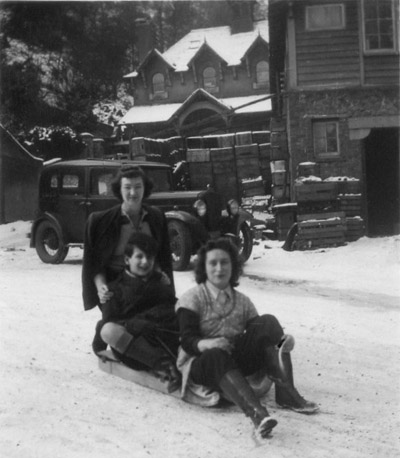
Friends Newsletter No. 60
July 2014
Friends are the guardians of Malvern's water heritage (Malvern Gazette 1 March 2013 p.14). We are an independent voluntary group who relentlessly promote research, conservation and celebration of the Springs, Spouts, Fountains and Holy Wells of the Malvern Hills and of Great Malvern as a Spa Town.
Family life at the Holy Well in the 1950s - Paul Brownsey, a Friend reminisces.
My uncle, William (Bill) Manuel, and his wife, Gladys, moved from Somerset to Leigh Sinton a couple of years after the war ended. Here he worked on a farm. In 1950 they were joined by my mother, Doreen Brownsey, and me, then aged five. At around the same time Uncle Bill Manuel started working at Cuff's factory at the Holy Well. Then the four of us moved into Holy Well Cottage at the side of the Holy Well building which was always referred to, by us and others connected with it, as "the factory".
Picture 1. The boy on the sled is me. The adults are: behind me, my aunt, Gladys Manuel; sitting on the front of the sled, Inga Little, who worked in the factory. The car in the background is, I think, Mr Cuff's. Note the crates in the yard.
At first my uncle worked in the factory, where the manager was a John Bradshaw. Subsequently, my uncle worked in Cuff's office in a hut-like building nearby. This was originally headed by a Mr Brown ("Brownie") when we moved there, but eventually he left and my uncle took over in the office. My aunt worked in the factory part-time, and my mother eventually worked there full-time. The whole Holy Well enterprise plus cottage was owned by Mr Cuff, who lived down the hill at The Ruby. After Mr Cuff died, around 1952, the factory passed to his nephew, Hugh Cawley, who was married to Kathleen. They had a son, Michael, who trained to be a clergyman in the Church of England. I was very fond of Kathleen and she seemed to take to me, having me in to watch television, though the reception was awful. Whether that was due to the general conditions in the area for reception or whether her television was a dud, I don't know.
One thing that strikes me about the operation of Cuff's pop factory is how much of the work was done by hand. There were machines for bottling the pop, but bottles were washed by hand. Every so often, all the workers would be gathered around a huge rectangular zinc tub and a big bottle-washing would get under way. You had to rub the bottles under water to get the labels off. I sometimes took part in this. There were some small automatic brushes fitted at the level of the top of the tub that whizzed round and round, and bottles were manoeuvred onto them so that the inside would get washed. These rotating brushes were dangerous. It was easy to get your hair caught up in the brushes as people bent over to reach down into the tub, especially as people were crowded together to do the bottle-washing so you couldn't always keep a big distance from the brushes.
'Still' Holy Well water was bottled by hand as it poured out of the hill behind  the factory. Sometimes I did this, to earn pocket money. There was a veranda on the factory, which was pulled down after we left. The veranda was a place where I often played on rainy days and it was a useful base for setting off my fireworks on rainy Bonfire Nights.
the factory. Sometimes I did this, to earn pocket money. There was a veranda on the factory, which was pulled down after we left. The veranda was a place where I often played on rainy days and it was a useful base for setting off my fireworks on rainy Bonfire Nights.
 the factory. Sometimes I did this, to earn pocket money. There was a veranda on the factory, which was pulled down after we left. The veranda was a place where I often played on rainy days and it was a useful base for setting off my fireworks on rainy Bonfire Nights.
the factory. Sometimes I did this, to earn pocket money. There was a veranda on the factory, which was pulled down after we left. The veranda was a place where I often played on rainy days and it was a useful base for setting off my fireworks on rainy Bonfire Nights.Picture 2. Holy Well Cottage (the rear part, in which we lived). On the left is the wall of the factory. Between it and the steps is a conveyor of metal rollers used to slide crates of bottles down to the delivery lorry.
All labelling of bottles was done by hand. A semi-circular alabaster slab sat upon a desk. It was spread with paste, and then a stack of labels was folded in a sort of butterfly shape, which enabled them to be set down quickly, one by one, on the slab. Then labellers would take up the filled and crowned bottles, hold them to the light to check for floating impurities, and then attach a label, smoothing it down and wiping away surplus paste with a cloth. I sometimes also did labelling for pocket money.
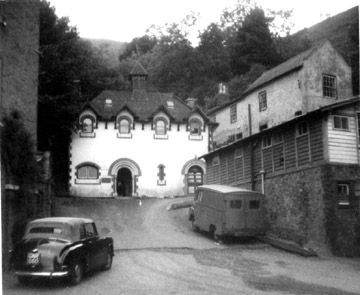
When I got home from the village school, I would often go into the factory and sit quietly by the open fire until my aunt and uncle had finished work.
Picture 3. The general view of the premises was taken by me on a return visit in 1962. Note the veranda and the crates have gone.
During the years I lived at the Holy Well, there were two or three occasions when the factory was asked to employ people who for one reason or another had had difficulties in holding down jobs. Whether this request came from some welfare charity or from the 'labour exchange', I'm not sure. I particularly remember one young man who was alleged to be 'slow', as it was characterised then, on account of being dropped on his head as a baby. He settled down very well at the factory and became a thoroughly reliable employee. Because of his success, at least one other person with a chequered employment history was referred to Cuff's.
A driver for much of the time I was there was Les Little. He had been a soldier in Germany at the end of WW2 and had married a German girl, Inga, who also worked at the factory for a while. In school holidays (it was a lonely place for an only child) I sometimes went out with the driver on his deliveries. I remember all-day journeys up to Stourport and Kidderminster. People, especially walkers on the hill who passed the factory and cottage, used to tell me how lucky I was to live in such a beautiful spot. I did not see it like that.
My family left in 1956 after some sort of dispute with the Cawleys, the details of which I am not sure of. Hugh Cawley died a year or two later. What 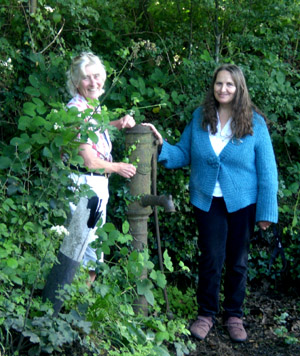 happened to his wife, I do not know. We understood that their son, Michael, suffered some sort of breakdown; I am not sure if he was ever ordained.
happened to his wife, I do not know. We understood that their son, Michael, suffered some sort of breakdown; I am not sure if he was ever ordained.
 happened to his wife, I do not know. We understood that their son, Michael, suffered some sort of breakdown; I am not sure if he was ever ordained.
happened to his wife, I do not know. We understood that their son, Michael, suffered some sort of breakdown; I am not sure if he was ever ordained.Cowleigh Road Pump to receive TLC
The good news is that the Cowleigh Road Pump is to become the latest restoration project, thanks to Ros and Tom Farrell. For many years this iron pump has remained uncared for on the Cowleigh Road, just along from Earl Beauchamp's Fountain. Plans are afoot to give the water feature a face lift and hopefully some of our readers may be able to assist. The iron top cap of the pump has been missing for a long while. According to Tom, who grew up in Longways Cottage opposite the pump, it was thrown up the bank behind the pump and is probably still in the undergrowth. The first appeal is for anyone with a metal detector who could help locate the old top then please let us know. If this quest is unsuccessful, the top fits over a circular rim about 14 centimetres across. If you know of a suitable iron cap then again do let us know.
Beneath the pump there is a cistern fed with spring water. This was the principal supply to Longways Cottage up to the 1970s. The water was piped under the road where a circular hand pump and electric motor ensured a flow to the cottage. A gate in the hedge opposite the pump once led to the cottage's front door. The original water supply has now been superseded by a bore hole supply and so the gate has fallen into disuse in favour of a vehicle entrance just up the road.
In the picture Cora and Ros brave the traffic to inspect the pump. Because of the traffic problem it is unlikely to be put back in water but it will be good to see it restored and perhaps decorated for the next Well Decorating weekend.
Boot Sale find needs identifying.

During the 18th and 19th centuries mineral waters in Europe were often bottled in stone bottles or Krugs (German) Cruches (French). These were made from local clays and generally held just under one litre of water. The old bottles turn up every now and again, the most common imported into England being the Selters (Seltzer) Water bottles that came in in their millions from the springs in the Hesse region of Germany. Also often found today are the old stone bottles of the Apollinaris brand from Germany. The spring was discovered by chance in 1852 in Georg Kreuzberg's vineyard at Bad Neuenahr and his name is often imprinted on the bottle alongside the brand name.
Imagine our surprise when browsing at a boot sale we spotted a stoneware bottle imprinted with the name Hector Bado Gibraltar. Was this a water bottle from this outpost of the former British Empire we wondered? Gibraltar in the 19th century relied heavily on recent rain to replenish the water reserves and the bottling of the spring water appears unlikely. Also imprinted on the bottle is the word "Schiedam". This is a town in Holland. 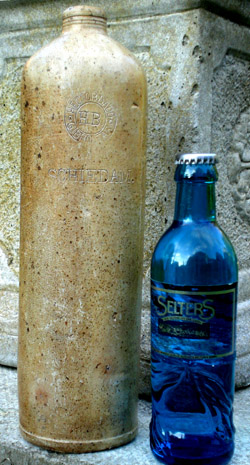

The bottles, that were returnable for reuse, gave rise to the expression "Der Krug geht so lange zum Brunnen bis er bricht". Translated this means "The pitcher goes to the well until its gets broken". In other words "you'll do that once too often".
The Gibraltar stone bottle has survived and we are now left pondering its provenance. Can you help shed light on its history? If so email Cora or Bruce.
In the pictures: i. a statue of a girl holding krugs in Selters; ii The mysterious Gibraltar stone bottle alongside a modern day bottle of Selters water.
Decade of News
In July this year we celebrate a decade of News going out to Friends of Malvern Springs and Wells. It was July 2004 that we first sent out a news bulletin to friends and since then our newsletters have become a major means of communication and comment. This one is the sixtieth indicating one approximately every two months. Thank you for all your support and may there be many more.
Malvern and Schweppes Grottoes
The Great British Grotto Grading scheme continues to grow and our web site, which hosts the scheme, is constantly being updated with new grottoes. We started the scheme after the demise of the Gothic Well, Malvern's best underground grotto site. Here a water source was once contained in an amazing underground cave like structure but in recent years was walled up. This drew our attention to the precarious plight of grottoes generally. Perhaps in future new owners may well be able to restore Malvern's grotto to former glory.
In the meantime we have another little problem which readers may be able to help solve. Schweppes, formerly famous for their Malvern bottled water, had a grotto at the Festival of Britain in 1951. We have looked everywhere for details but so far no luck. Can you help and was this Malvern's other spring water grotto, albeit in Battersea Park, London?
For more details of grottoes go to grotto.directory on the web.
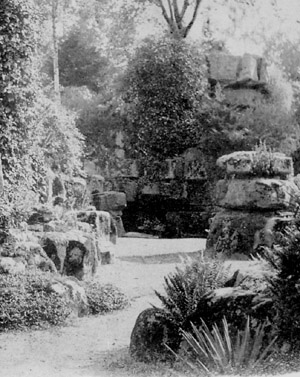
Yet Another Well discovered - The Dropping Well.
Recent research into grottoes has led us to a local well that until now has gone unrecognised as an important Malvern water feature. In Madresfield Court grounds there is a rock garden that was commissioned by the fifth Lord Beauchamp in 1876. It was installed by Pulhams of Broxbourne, one of the leading landscape companies at the time and it became one of their masterpieces. This theatrical creation is built on three levels and stands thirty feet high in places. It was built entirely of Pulhamite, a man made stone made famous by the installation company and used extensively for such prestigious projects.
The sheer scale of the works is impressive with towering archways that span the paths through the gorges. At the foot of the central section the Dropping Well was sited making a water feature that enhances the overall appeal of the rockwork. This work was all carried out in 1878/9, being completed in July. At the time of publication of this newsletter it is 135 years old. As far as we are aware water continues to flow. The well can be seen in the centre of the picture above that dates from circa 1900. Our enquiries continue.
Email: springs@thespas.co.uk (click here to send an email)
Website: Click Here
SUPPLEMENTARY INFORMATION
The home page can be accessed by clicking website above.
Contact Information:
Friends main website - www.MalvernWaters.com
 Newsletter Archive which can also be accessed from our WEB SITE INDEX.
Newsletter Archive which can also be accessed from our WEB SITE INDEX.
Friendship - There is no charge made for joining Friends of Malvern Springs and Wells. Just let us have your email address and we will send our newsletters, which are usually two monthly. Please be aware that some email addresses block large circulation emails. Do feel free to participate in our activities by contacting us below.
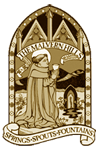
Best wishes, Cora & Bruce
Bruce Osborne, Tower House, Tadworth, Surrey. KT20 5QY
Tel. 01737 213169 email bruce@thespas.co.uk
Tel. 01737 213169 email bruce@thespas.co.uk
Cora Weaver, 4 Hall Green, Malvern, Worcs. WR14 3QX
Tel. 01684 561215 email cora@malvernspa.com
Tel. 01684 561215 email cora@malvernspa.com
1) TOPOGRAPHICAL LOCATION:
Malvern Hills - arguably Britain's original National Park
3) INFORMATION CATEGORY:
History & HeritageFriends Newsletter


